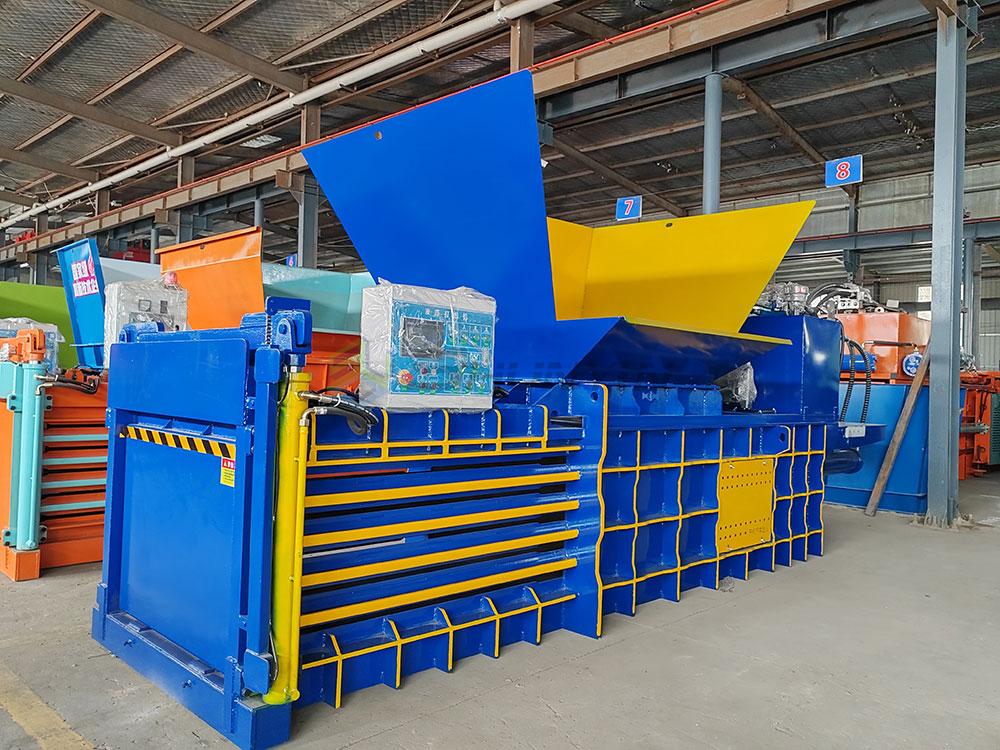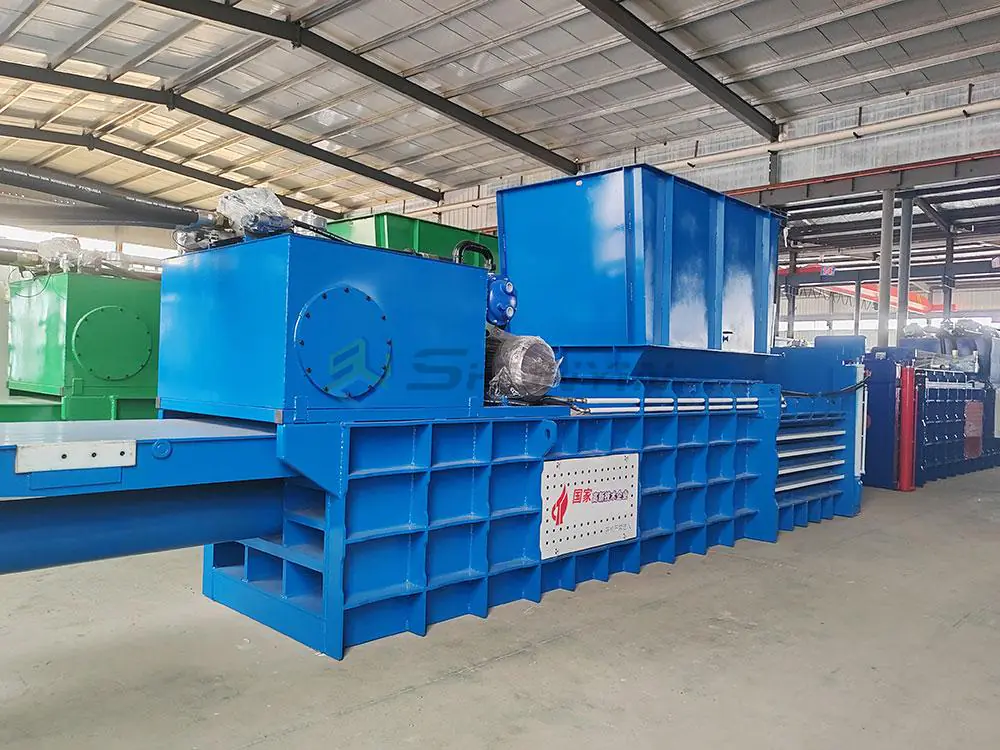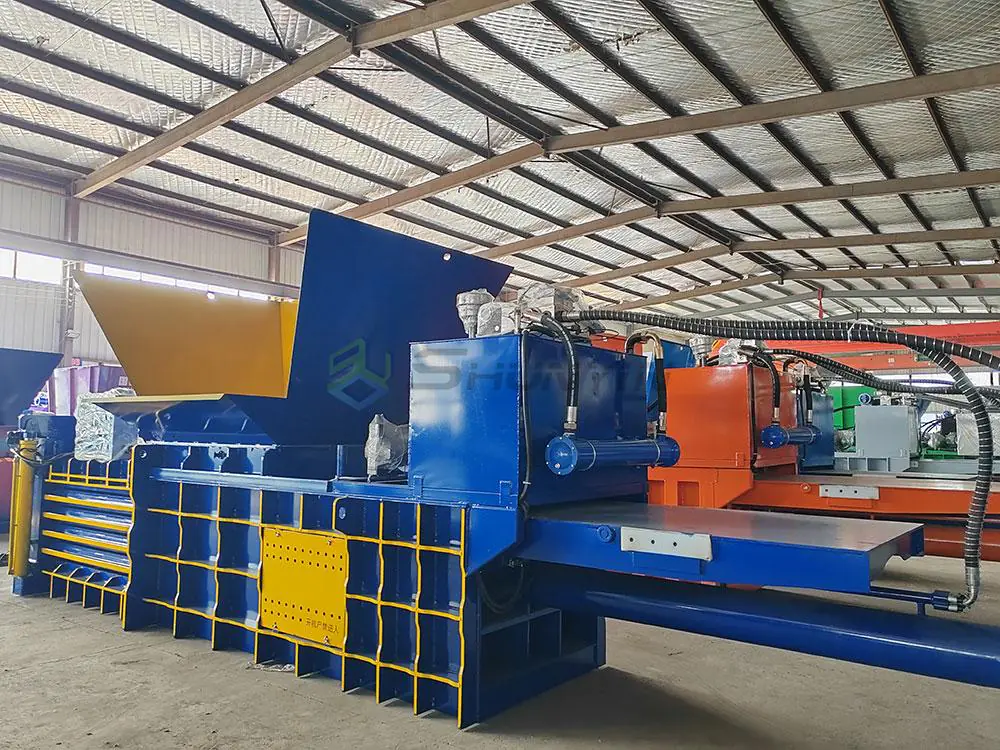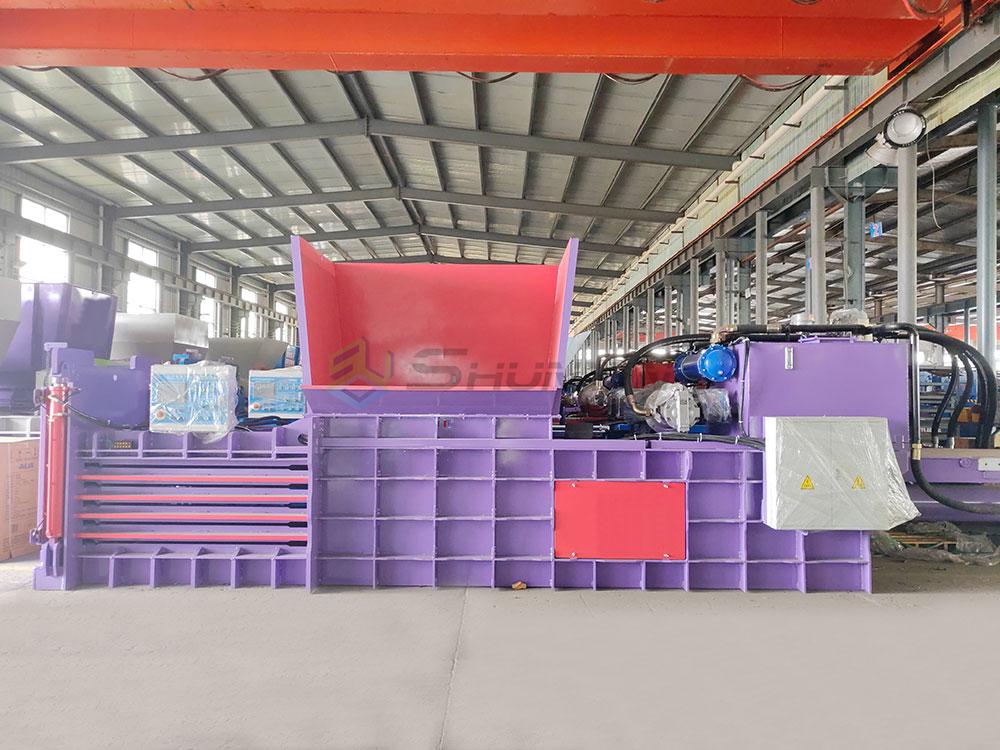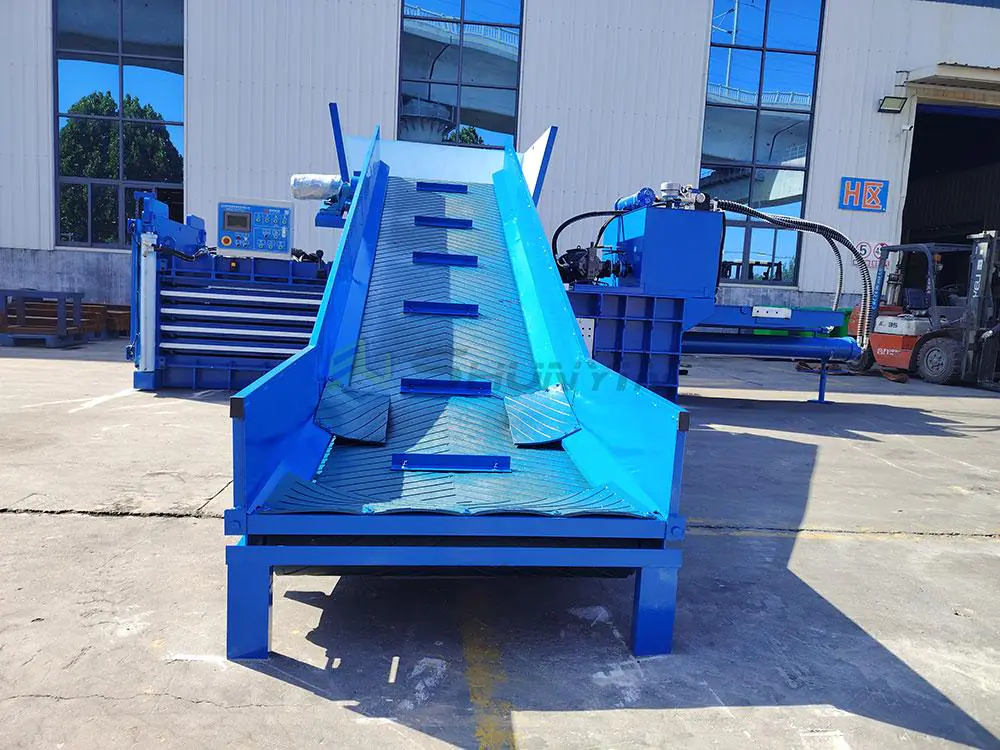Cardboard waste piles up relentlessly in warehouses and factories. Storage costs drain operational budgets quickly. Automatic balers eliminate manual labor while boosting baling efficiency dramatically.
Fully automatic horizontal balers are ideal for cardboard processing. Our SY-950 series delivers unmatched 12-ton/hour throughput with continuous feeding and self-tie systems that minimize operator involvement while maximizing bale density.

Smart automation solves cardboard recycling challenges better than manual alternatives. Discover critical insights about auto-baling technology as we answer key questions.
What Defines the Best Automatic Baler for Cardboard?
Warehouses struggle with inconsistent bale quality. Uneven density wastes container space during shipping. Equipment selection becomes crucial for profit margins.
The optimal baler combines precision force control with intelligent PLC automation. Top-tier systems like our SY-950 achieve consistent 500kg bales using 120-ton compression while maintaining <1% downtime.

Critical Evaluation Parameters for Peak Performance
Selecting equipment demands understanding operating thresholds. Five factors determine real-world performance.
Performance Comparison Matrix
| Model Feature | Economy Class | Industrial Grade (Recommended) | Heavy-Duty Industrial |
|---|---|---|---|
| Max Throughput | 3-5 tons/hour | 8-12 tons/hour | 15-18 tons/hour |
| Automation Level | Semi-Auto | Full Auto PLC | AI-Optimized Auto |
| Pressure Accuracy | ±10% | ±3% | ±1% |
| Daily Capacitance | <15 tons | 40-60 tons | 80-100 tons |
Throughput claims require verification. Run three-day material trials before purchasing. Our facility offers live demonstrations with your cardboard grades. Conveyor integration boosts productivity. Manual feeding bottlenecks automated systems. We design custom infeed configurations matching facility layouts. Maintenance accessibility impacts uptime. All key components need tool-free access. Observe a full cleaning cycle during inspection.
Material sensors prevent overloads and jams. Photoelectric eyes optimize chamber fill rates – our German clients report 28% faster cycles with this upgrade. Test precision settings yourself: contact [email protected] for booking.
What Investment Range Applies Cardboard Balers?
Pricing confusion delays purchasing decisions. Hidden equipment costs emerge during operation. Transparent costing supports better budgeting.
Automatic cardboard balers range from $22,000–$85,000. Our SY-550V delivers core automation at $42,000 while maintaining competitive throughput of 6 tons/hour with PLC controls.

Comprehensive Cost Structure Analysis
Look beyond machine prices to understand lifetime value. Operational expenses determine ROI.
Lifetime Cost Breakdown
| Cost Type | Semi-Auto ($22K) | Standard Auto ($42K) | Premium Auto ($85K) |
|---|---|---|---|
| Machine Purchase | $22,000 | $42,000 | $85,000 |
| Annual Labor Savings | $12,000 | $28,000 | $41,000 |
| Maintenance Average | $2,500/year | $1,800/year | $950/year |
| Expected Lifespan | 8-10 years | 12-15 years | 15-18 years |
Budget for essential peripherals. Compulsory dust extraction adds $3,500-$15,000. Consider our compact cyclone filters. Utility upgrades affect expenses. Power requirements range 30-100kW – our units average 40% efficiency improvements versus competitors. Residual value matters long-term. Maintained balers retain 35% value after 10 years. Document all service records diligently.
Financing options ease acquisition. We offer lease-to-own plans approved in Canada and Japan. Calculate potential savings: WhatsApp 0086 13505379893 for ROI worksheets1.
How Do Automatic Balers Enhance Recycling?
Material handlers spend excessive time on baling operations. Inconsistent cycles cause processing delays. Automation reclaims productivity dramatically.
Auto-balers streamline high-volume recycling through timed compression cycles and self-monitoring systems. Reduced manual involvement drops labor costs while improving bale consistency significantly.

Operational Transformation Achievements
Documented results validate efficiency claims. Three key performance shifts emerge.
Productivity Before/After Automation
| Metric | Before Automation | After Automation | Change |
|---|---|---|---|
| Daily Throughput | 12 tons | 22 tons | +83% |
| Labor Hours Required | 16 person-hours | 4 person-hours | -75% |
| Rejected Bales | 9% | 0.8% | -91% |
| Space Utilization | 350m² | 140m² | -60% |
Safety improvements provide hidden value. Automated systems eliminate compression zone entries – Australian facilities reported 100% injury reduction. Maintenance coordination boosts uptime. Our predictive diagnostics alert technicians before failures. Sensor history identifies wear patterns proactively. Bale consistency enhances sales value. Uniform dimensions and weights help establish premium recycling partnerships.
Transition phases need proper planning. Implement training weeks before machine commissioning. Schedule installation tours at https://lemonchiffon-shark-638535.hostingersite.com/contact/.
What’s the Correct Operation Sequence?
Improper operation causes machine damage frequently. Skipping safety checks compromises operator protection. Systemized procedures prevent accidents.
Operators must follow four steps precisely: load material evenly; initiate compression via safety buttons; monitor automatic tying; remove bales after pressure release. Never bypass safety interlocks.

Comprehensive Operational Protocol
Detailed procedures ensure consistent results while extending equipment life.
Maintenance Integration Schedule
| Frequency | Mechanical Tasks | Hydraulic Checks | Safety Inspection |
|---|---|---|---|
| Daily | Clean chamber walls | Verify fluid levels | Test emergency stops |
| Weekly | Lubricate ram guides | Inspect hoses for leaks | Verify dual-hand controls |
| Monthly | Measure wire tension | Filter cleanliness rating | Calibrate door sensors |
| Quarterly | Ram alignment adjustment | Oil particle count test | Structural integrity exam |
Material preparation prevents 68% of malfunctions. Flatten large boxes before feeding – irregular loads cause uneven pressure distribution. Moisture monitoring preserves hydraulic systems2. Wet cardboard introduces damaging condensation. Our integrated humidity sensors detect >18% moisture automatically. Cycle optimization maximizes throughput. Balance chamber fill level with compression duration. Overfilled chambers strain hydraulics – underfilled ones waste energy.
Record performance parameters daily. Pressure/time metrics reveal developing issues. We provide remote monitoring setups via PLC connection. Need operation manuals? Email [email protected] for model-specific guides.
How Does Auto Baling Technology Function?
Complex machinery intimidates new operators. Hidden mechanisms cause maintenance confusion. Understanding basic principles enhances troubleshooting capability.
Auto balers compress materials using hydraulics, then secure bales automatically via programmed strapping cycles. Sensors constantly monitor chamber fill, pressure curves, and tie tension without human input.
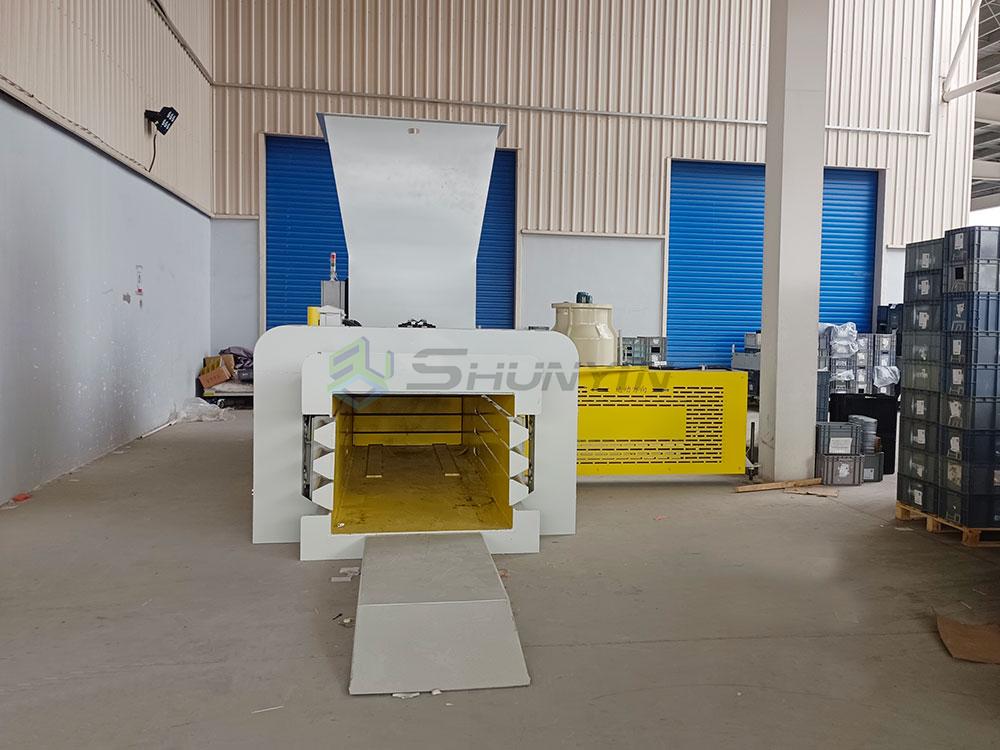
Inside the Automated Compaction Process
Three core systems interact seamlessly during operation.
Auto-Baling Cycle Breakdown
| Phase | Duration | Key Mechanisms | Critical Parameters |
|---|---|---|---|
| Infill/Detection | 60-80 seconds | Conveyor feeds; photoeyes | Fill density: 85-100kg/m³ |
| Compression | 45-55 seconds | Main ram extends | Pressure: 50-150 tons |
| Tying/Ejection | 30-40 seconds | Wire feeders; pusher plate | Tie tension: 120-150kg force |
Hydraulic intelligence achieves precision. Advanced PLCs manage pressure profiling – our systems deliver gradual force application to prevent material tearing. Software customization addresses material variations. Cardboard grades require different compression curves. We program settings for corrugated vs chipboard stock. Sensor networks enable self-correction. Position feedback loops adjust ram motion 200 times per second to counter irregularities.
Temperature management protects components. Hydraulic coolers stabilize oil viscosity during continuous cycling. Our Canadian models include cold-weather kits. Explore technical specifications: WhatsApp 0086 13505379893 for engineering diagrams.
Conclusion
Automatic balers optimize cardboard recycling through consistent high-density compression, labor reduction, and precise operational control delivering measurable ROI.


